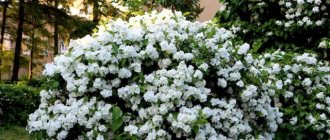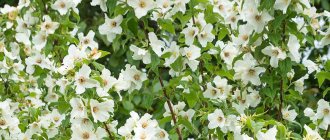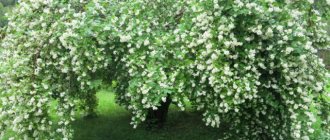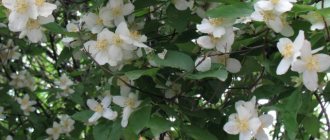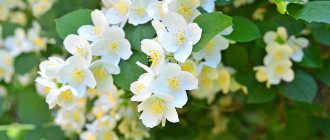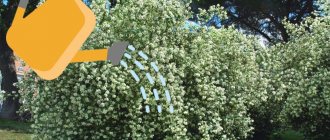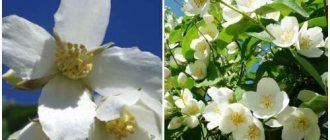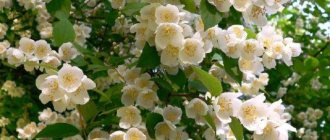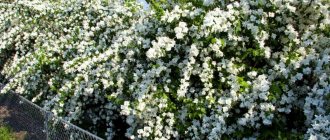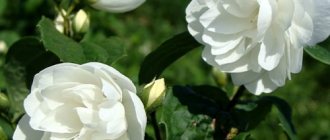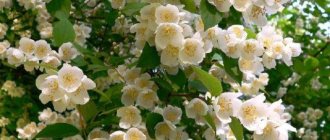When can you reproduce?
Mock orange belongs to the Hydrangeaceae family, but is popularly called “garden jasmine.” The shrub received the Latin name “Philadelphus” in honor of the king of Egypt Ptolemy Philadelphus, and the Russian name “mock orange” - due to the fact that smoking pipes and mouthpieces were made from its hollow stem.
Chubushnik - garden decoration
The height of the bush is 1-2.5 m, the stems are flexible, thin, the leaves are light green and bright. Flowers are collected in inflorescences, which are formed on short lateral shoots. They can be simple, cup-shaped, goblet-shaped, semi-double or terry, white or cream shades.
Mock orange blooms at the end of June - July for 3 weeks, when the spring colors have already faded, garden jasmine begins to delight with its beauty and fragrance.
Mock orange blossom
Mock orange is an unpretentious plant and can be propagated by all methods known in gardening. How mock orange jasmine reproduces:
- dividing the bush;
- cuttings;
- seeds;
- layering.
The timing when reproduction can be carried out depends on the selected breeding method:
- The favorable period for dividing the bush is March-April.
- When propagating by cuttings, three methods are used: spring, summer and autumn-spring. Autumn harvesting of cuttings begins after the leaves fall. Lignified gray cuttings are cut and left for winter storage in a cellar or basement at a temperature of 3-5 ℃ above zero, while the stems are deepened into a container with wet sand. You can start planting in the spring, when the flower buds swell. When cutting in spring, young green shoots are chosen before the bush begins to flower; how to propagate mock orange by cuttings in the summer - after flowering.
- Seed propagation is carried out in the fall - in November or in the spring - in April.
- Layerings are strong, well-developed shoots, dug in at the end of April - beginning of May, throughout the season, you must not forget to water them, and in the fall, the cuttings that have taken root can already be transplanted to a permanent place of residence.
Description and characteristics of the plant
Jasmine belongs to the Olive family and is noticeably different from other representatives of its genus. It grows as an erect or climbing shrub with slender shoots bearing simple, dark green, trifoliate leaves.
During flowering, corymbose inflorescences are formed at the top of the stems, collected from single flowers with a pronounced sweet aroma. Inedible berries are subsequently formed inside the long corollas. The color of the petals can be white, pink and yellow, depending on the variety.
On a note! The flowers of the plant are often added to green tea as an aromatic component, and its essential oil is used to make perfumes.
Jasmine does not require any painstaking care, so summer residents willingly use it to decorate their plots. Today, there are more than 300 species of this shrub in cultivation. The most popular varieties include:
- multi-flowered;
- drug;
- Jasmine Lerata;
- shrubby;
- flattened;
- Chinese;
- sambac.
Most species of this heat-loving crop grow in South America, Africa, Australia, Asia, and the Mediterranean. In Russia and other European countries, only 2 varieties of the plant are grown - bush jasmine with yellow flowers and white medicinal jasmine.
Shrub jasmine with yellow flowers
Propagation by seeds
How to propagate garden jasmine in spring and summer
How to propagate mock orange from seeds? This is the longest and most difficult method of reproduction. Moreover, using this method, you may not get the desired result, since only species characteristics are transmitted by seeds, and varietal characteristics are lost. But if you already have a treasured box of seeds in your hands, plucked from a neighbor’s bush, it’s worth trying to grow a shrub.
Mock orange seeds
When sowing seeds in autumn, you must perform the following steps:
- Collect seeds from a ripe capsule picked in September, put them in a bag or bag and put them in a cool place. Stratification lasts from 50 to 60 days.
- Sowing of seeds is carried out on the site, in open ground. The plot of land must be prepared in advance: dig up, apply fertilizer, form ridges. In November, the seeds are mixed with sand and scattered in ridges. The seeds are sprinkled with dry compost or straw on top and covered with branches to protect them from the wind. After the snow melts, the branches are removed, and the area with the seedlings is shaded from direct sunlight.
Mock orange seeds can be purchased at the store
In spring, seeds are sown in April in a prepared container with soil. The seeds must first be prepared:
- Place the seeds in a cloth bag and dip it in a cup of water at room temperature for 2 hours.
- Place the bag of seeds in sawdust or peat for 3 days. During this time, the seeds will swell and germinate faster after planting.
- Mix the prepared seeds with sand, sow in a pre-prepared box with soil, which is covered with glass or film to create a greenhouse.
- Ventilate the resulting greenhouse daily and spray the crops 2 times a day. The first shoots should appear in a week.
- It is recommended to treat the seedlings with a weak solution of potassium permanganate to avoid the “black leg” disease. Continue ventilation of the greenhouse and spraying.
- After the appearance of the fourth leaf, the seedlings dive.
- At the beginning of summer, strengthened seedlings are transplanted into open ground, to a shaded area.
- For winter protection from frost, the sprouts should be covered with dry compost or peat.
- Next spring, to form a dense bush, the above-ground part must be cut off and transplanted to a permanent place in the fall.
Soaking the seeds
What are the problems with juniper propagation?
Properly planted in open ground, juniper with proper care does not create any special problems during cultivation. The plant has good immunity to various diseases and pests. For preventive purposes, it is still necessary to carry out antifungal treatment with fungicides. Insecticides are effective against aphids, spider mites, and scale insects.
It happens that the planting is done correctly, the plant is well cared for, but yellow needles are found deep in the crown. These are usually signs of needle fall caused by lack of moisture. This is a completely natural process. If the young needles that appeared this year remain green, then there is no need to worry.
Read more about how to treat rust on juniper.
It happens that under the pressure of snow the bush falls apart into two parts. To restore it, you need to lubricate the split areas with a special wound balm. At the break point, all parts of the branches must be pressed tightly and secured. After fusion, the retainer can be removed.
Propagating juniper is not difficult. To transform a summer cottage, a few coniferous bushes are enough. If all planting rules are followed, they will please the eye for a long time.
Cuttings
How to propagate gooseberries in spring, summer and autumn
Cuttings of mock orange are suitable for propagating varietal species of shrubs; this method preserves all the characteristics of the variety. This method is also convenient because cuttings can be carried out throughout the season.
Mock orange seedlings
Spring propagation by cuttings is carried out in late April - May, before flowering begins. To do this, young green branches are broken off together with the heel (a piece of bark from the main shoot), which promotes better root formation. The required length of the cutting is 5-7 cm. The lower leaves of the cutting must be torn off, leaving only one pair, so that all the strength of the branch goes towards creating the root system. You need to prepare a pot with soil mixture in advance: 1 part peat is mixed with 1 part sand. Stick the prepared cuttings into the prepared soil to a height of 2 cm. Cover the top of the pot with a cut plastic bottle to create a greenhouse climate. It is recommended to ventilate the cuttings daily, removing the plastic cap, and spray them. The first roots will appear in 2-3 weeks, and it will be possible to transplant the sprout into the garden only in mid-autumn.
Cuttings of mock orange in spring
Propagation of mock orange by cuttings in summer is also possible. If there is not enough time in the spring and the garden jasmine has already bloomed, then mock orange cuttings are carried out in the summer. Immediately after flowering, in June-July (depending on the variety), young branches are cut with pruning shears, making an oblique cut at the bottom and a straight cut at the top. Further steps for cutting mock orange in the summer are the same as for spring planting.
When cutting in autumn, after the leaves have fallen, already lignified branches, 15 cm long, are cut with pruning shears. Prepared cuttings can be stored in a plastic bag in the refrigerator or buried in sand in the cellar. You can plant cuttings in open ground when the soil has already warmed up or in a pot in early spring. The shoots go deep into the ground to the top bud.
Mock orange cuttings in a growth stimulator
Important! The optimal temperature for the formation of the root system is 20-22 °C above zero. When cold weather is expected, it is better to leave the container with the planted cuttings in the house.
For any cutting method, it is recommended to treat the cuttings with a growth stimulant before planting. How to root mock orange. You can use home remedies (aloe juice, yeast solution, willow water) or chemicals (kornevin, zircon, heteroauxin). The twig is dipped in the solution for a period of 6 to 12 hours.
Important! Do not forget about watering; the soil in which the cuttings grow should always remain moist.
Propagation by cuttings is a fairly simple method and always produces results.
How to propagate juniper from cuttings
It is not difficult to take cuttings from a plant; the main thing is to know and follow all the subtleties so that the rooting process is successful and quick. Step-by-step instructions for the process are outlined below.
Preparation of planting material
First you need to choose the appropriate planting material. There are several rules:
- It is advisable to harvest cuttings from bushes older than 8 years - then the young growth will retain all the characteristics of the mother plant.
- When it is necessary to grow a spreading bush, the cutting should be cut from the middle part of the bush. If you need a vertical one - from the top. One mother bush will be enough to renew the planting.
- The shoot should be green. It needs to be cut early in the morning.
- When pruning, you should grab the part of the branch on which the shoot grew, so that it turns out with the so-called heel. This will speed up the rooting process.
- You need to divide the branch into pieces 12 cm long. It can be longer, but not more than 25 cm.
- It is necessary to harvest cuttings only with a sharp and sterile instrument.
How to properly prepare a cutting
The preparatory stages are as follows:
- Remove the needles on the shoot with a sharp knife without damaging the bark. The needles should remain only at the very top.
- Treat the bottom of the cutting with a growth stimulator or similar agent - you need to dilute sugar in warm water in a ratio of 1 to 2.
- A day later, plant the shoots in a nutrient substrate prepared in advance.
How to root a cutting
The nutrient substrate for juniper propagation must be loose, breathable, and moisture-absorbing. These characteristics correspond to a mixture of peat and sand, in equal proportions. For good air exchange, add a little charcoal and perlite.
Important! If several cuttings are planted, then there should be 6–8 cm between them. The rooting process looks like this:
The rooting process looks like this:
- The container is filled with soil mixture, in which a hole is formed 30–40 mm deep and 10 mm in diameter.
- A cutting is placed in the hole, the soil around it is compacted and irrigated abundantly.
- The period for the formation of viable roots is at least 25 days.
Reproduction by layering
Chubushnik shneeshturm - description, planting and care
How to propagate mock orange by layering is very simple. Reproduction by layering is a very effective and uncomplicated method. To do this, at the beginning of spring, before the buds open, the following actions are carried out:
- The soil around the bush needs to be dug up, fertilized and holes made 1.5-2 cm deep.
- Place layering in the holes, pour water on top and sprinkle with soil.
- The top of the layer is not buried; it must be tied to a peg so that its growth is vertical.
Important! For reliability, secure the mock orange shoots in the hole with slingshots made of twigs or wire.
After a while, roots and sprouts form from each bud on the buried shoot. As young shoots grow, they are hilled up to a height of 10-15 cm.
Reproduction of mock orange by layering
During the summer period, water and loosen the growing bushes. In the fall, cut cuttings from the main bush, dig them up and use pruning shears to divide them between the buds into bushes. Plant the prepared seedlings on the site.
Rules for planting cuttings in the ground
If you plan to plant a rooted cutting directly into the ground, and not grow it in a pot at home, it must be prepared. A week before planting, you need to start hardening the young plant, then it will not experience shock and will better adapt to the new place.
The soil must be prepared in advance. The soil is dug up, fertilizers are applied and watered just before planting the cuttings.
After the procedure is completed, the plant is hilled up and special attention is paid to it in the first month. The seedling must be watered regularly and the soil around it must be loosened.
The next year, the top of the bush is trimmed so that it grows with a spreading crown and is lush.
Soil preparation
If an adult bush has grown too much, it can be divided into several parts. How to plant jasmine by dividing the bush correctly? It is better to start this process in spring or autumn. A day before the jasmine bush is dug up, it is watered abundantly. After being removed from the ground, the plant is divided into several parts, each of which must have roots.
Roots that are too long are shortened, and the length of the shoots is also slightly reduced. When planting, jasmine is buried to the lower buds. The land must be pre-fertilized and disinfected. After planting, the plants need to be watered. The rooting process will take 3-5 weeks in this case. The crop can also be propagated by layering.
You should be puzzled by the question of how to propagate jasmine by cuttings if there is a lot of material left after pruning, or there is not yet an adult bush on the site that can be divided. This method can also be used when several branches for planting were received from neighbors in the country. Propagation by cuttings will require a certain amount of time, but as a result the gardener will receive a large number of new plants that are well adapted to growing in his area.
vote
Article Rating
Dividing the bush
How to propagate mock orange by dividing the bush? This can be done in early spring, before the buds open, or in the fall, after the leaves have fallen. When dividing a bush you need:
- First, a day before, thoroughly water the jasmine.
- Then carefully dig up the bush and free it from clods of earth.
- The next step is to divide the garden jasmine root using pruning shears. The number of new bushes can be according to the number of shoots, the main thing is that they have a sufficient number of roots left. If the root system is not sufficiently developed, divide it into parts of several shoots.
- The upper part of the shoots and the lower part of the roots of the bushes are cut off.
- In the new place, holes are prepared to the depth of the first buds on the shoots. Mix the soil with fertilizers, compost or peat, treat with manganese or fungicides. Pour a bucket of water into the hole.
- Place the bushes in the holes, cover with prepared soil, and water.
Reproduction by dividing the bush
When planting in spring, the bushes will take root and strengthen in a new place by autumn; when planting in autumn, it is necessary to prepare the seedlings for winter - cover them with dry peat or cover them with spruce branches.
Mock orange shelter for the winter
Jasmine care
You need to know not only how to plant jasmine, but also how to care for it after that. First of all, it is important to choose the right place for planting. Terry jasmine is a light-loving plant. It is advisable to plant it in open areas.
Why garden or indoor jasmine does not bloom and what to do
After transplantation, you can apply complex mineral fertilizers. Organic materials used include rotted manure, wood ash, and a solution of bird droppings.
In spring and summer, the bush requires a lot of moisture. The soil should always be moist. Watering is carried out in the evening after sunset. If you water jasmine during the day, there is a high probability of burns on the foliage. Be sure to water the roots with warm water. Watering with cold water is prohibited.
Do not forget that caring for shrubs includes the prevention of various diseases and pests. Fortunately, pests are rare due to the strong aroma that the inflorescences emit. In early spring, it is still recommended to spray jasmine with Bordeaux mixture.
Additional Information! When pests appear, the bush is first sprayed with a soap solution. If this does not help, you will have to resort to insecticides.
Another important procedure is pruning. First, all weak and dry branches are removed. Then the longest or inward growing stems are cut off. The bush can be shaped into a ball. For pruning, a sharp pruning shears are used, which does not leave creases on the branches.
Newly planted layerings, cuttings and parts of the bush must be covered for the winter so that the plants do not die due to frost. You can use spruce branches, wormwood, peat or agrofibre as shelter.
Propagation of jasmine is a simple procedure that does not require special knowledge in floriculture. Young cuttings and layering quickly take root in a new place.
Care after breeding
Young mock orange seedlings will require attention at first:
- When choosing a planting site, you need to take into account in advance that the plant does not like prolonged exposure to direct sunlight. If it was not possible to find a shaded place, then the young bushes will have to be shaded.
- Mock orange needs to be fertilized. When planting, fertilizers were already applied to the hole, which should be enough for two years, but still, in small quantities 2 times a year, it would not hurt to treat the plant with organic and mineral fertilizers. In the spring, the plant needs nitrogen (a diluted mixture of mullein and chicken droppings is suitable) and potassium and superphosphate in the summer to strengthen the root system after the winter cold and to grow green mass.
- The bushes need to be watered regularly; it is better to do this in the morning or evening with warm, settled water.
- After watering, the soil in the tree trunk circle is loosened to provide oxygen access to the roots. To retain moisture, you can cover the ground with mulch.
- The beds with young mock orange must be regularly cleared of weeds.
- In spring or autumn, molding pruning of the bush is carried out to obtain a lush mass and the desired shape.
- When preparing for winter cold, young mock orange needs to be covered. A film cap, spruce branches, dry leaves or peat are suitable for this. An adult plant does not need protection from frost.
- In the spring, after removing winter protection from the bushes, they must be treated with fungicides and insecticides to protect them from pests and diseases.
Mock orange is a gentle and unpretentious garden decoration. To propagate it, you can use any of the gardening methods. Propagating garden jasmine does not take much time and does not require much effort. The bushes have a high ability to take root and reproduce. The result will delight you in 4-5 years with beautiful flowering mixborders or hedges with an exquisite aroma.
How to propagate garden jasmine correctly?
Short side branches with flowers go to the cuttings. With a sharp movement we tear off the branch from the main shoot. There should be a small piece of wood with bark left on it - the heel.
The lower part of the collected cuttings is already woody, but the tops are still green. Therefore, the cuttings are called semi-lignified.
To root them you will need: sand, peat, drainage material (for example, expanded clay), a container and a cap or polyethylene for covering.
Place a layer of drainage on the bottom of the pot, and a mixture of peat and sand in equal proportions on top. It is better to mix them already slightly moistened.
Pour clean sand on top with a 2-3 cm layer and cover with a fungicide solution.
On the cuttings we cut off the lower leaves and inflorescences.
Soak mock orange cuttings in a stimulant solution (Epin) for 12 hours (not necessary, but recommended).
Dip a cut of a garden jasmine cutting into root formation stimulator powder.
We plant in the prepared container at an angle of 30-40°. The petioles of the lower leaves should not be immersed in the sand!
